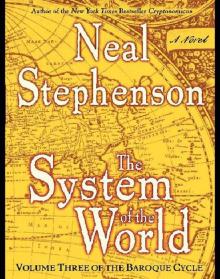- Home
- Neal Stephenson
Mother Earth Mother Board Page 3
Mother Earth Mother Board Read online
Page 3
Daily and Wall preside over this operation, which is Western at the top and pure Thai at the ground level, with a gradual shading of cultures in between. FLAG has dealings in many countries, and the arrangement is different in each one. Here, the top level is a 50-50 partnership between FLAG and Thailand's CAT. They bid the project out to two different large contractors, each of whom hired subcontractors with particular specialties who work through sub-sub-contractors who hire the workers, get them to the site, and make things happen. The incentives are shaped at each level so that the contractors will get the job done without having to be micromanaged, and the roads seem to be crawling with inspectors representing various levels of the project who make sure that the work is being done according to spec (at the height of this operation, 50 percent of the traffic on some of these roads was FLAG-related).
The top-level contracts are completely formalized with detailed specifications, bid bonds, and so on, and business at this level is done in English and in air-conditioned offices. But by the time you get to the bottom layer, work is being done by people who, although presumably just as intelligent as the big shots, are fluent only in Thai and not especially literate in any language, running around in rubber flip-flops, doing business on a handshake, pulling wads of bills out of their pockets when necessary to pay for some supplies or get drinks brought in. Consequently, the way in which the work is performed bears no resemblance whatsoever to the way it would be done in the United States or any other developed country. It is done the Thai way.
Not one but two entirely separate pairs of conduits are being created in this fashion. Both of them run from the idyllic sandy beach of Ban Pak Bara on the west to the paradisiacal sandy beach of Songkhla on the east - both of them are constructed in the same way, to the same specifications. Both of them run along highways. The southern route takes the obvious path, paralleling a road that runs in a relatively straight line between the two endpoints for 170 kilometers. But the other route jogs sharply northward just out of Ban Pak Bara, runs up the coast for some distance, turns east, and climbs up over the bony spine of the peninsula, then turns south again and finally reaches Songkhla after meandering for some 270 kilometers. Unlike the southern route, which passes almost exclusively over table-flat paddy land, easily excavated with a backhoe, the northern route goes for many kilometers over solid rock, which must be trenched with jackhammers and other heavy artillery, filled with galvanized steel conduit, and then backfilled with gravel and concrete.
This raises questions. The questions turn out to have interesting answers. I'll summarize them first and then go into detail. Q: Why bother running two widely separated routes over theMalay Peninsula?
A: Because Thailand, like everywhere else in the world, is full ofidiots with backhoes.
Q: Isn't that a pain in the ass?
A: You have no idea.
Q: Why not just go south around Singapore and keep the cable in the water, then?
A: Because Singapore is controlled by the enemy.
Q: Who is the enemy?
A: FLAG's enemies are legion.
The reason for the difficult northern route is FLAG's pursuit of diversity, which in this case is not a politically correct buzzword (though FLAG also has plenty of that kind of diversity) but refers to the principle that one should have multiple, redundant paths to make the system more robust. Diversity is not needed in the deep ocean, but land crossings are viewed as considerably more risky. So FLAG decided, early on, to lay two independent cables on two different routes, instead of one.
The indefatigable Jim Daily, along with his redoubtable inspector Ruzee, drove us along every kilometer of both of these routes over the course of a day and a half. "Let me ask you a naïve question," I said to him, once I got a load of the big rock ridge he was getting ready to cut a trench through. "Why not just put one cable on one side of that southern highway and another cable on the opposite side?" I found it hard to imagine a backhoe cutting through both sides of the highway at once."
They just wanted to be sure that there was no conceivable disaster that could wipe out both routes at the same time," he shrugged.
FLAG has envisioned every possible paranoid disaster scenario that could lead to a failure of a cable segment and has laid action plans that will be implemented if this should happen. For example, it has made deals with its competitors so that it can buy capacity from them, if it has to, while it repairs a break (likewise, the competitors might reserve capacity from FLAG for the same reason). Despite all this, FLAG is saying in this case: "We are going to cut a trench across a 50-mile-wide piece of rock because we think it will make our cable infinitesimally more reliable." Essentially, they have to do it, because otherwise no one will entrust valuable bits to their cable system.
Why didn't they keep it in the water? Opinions vary on this: pro-FLAG people argue that the Straits, with all of their ship traffic, are a relatively hazardous place to put a submarine cable and that a terrestrial crossing of the Malay Peninsula is a tactical masterstroke. FLAG skeptics will tell you that the terrestrial crossing is a necessity imposed on them because Singapore Telecom made the decision that they didn't want to be connected to FLAG.
Instead, Singapore Telecom and France Telecom have been promoting SEA-ME-WE 3, that Southeast Asia-Middle East-Western Europe 3 cable, a system whose target date is 1999, two years later than FLAG. SEA-ME-WE 1 and 2 run from France to Singapore and 3 was originally planned to cover the same territory, but now its organizers have gotten other telecoms, such as British Telecom, involved. They hope that SEA-ME-WE 3 will continue north from Singapore as far as Japan, and north from France to Great Britain, covering generally the same route as FLAG. FLAG and SEA-ME-WE 3 are, therefore, direct competitors.
The competition is not just between two different wires. It is a competition between two entirely different systems of doing business, two entirely different visions of how the telecommunications industry should work. It is a competition, also, between AT&T (the juggernaut of the field, and the power behind most telecom-backed systems) and Nynex (the Baby Bell with an Oedipus complex and the power behind FLAG). Nynex and AT&T have their offices a short distance from each other in Manhattan, but the war between them is being fought in trenches in Thailand, glass office towers in Tokyo, and dusty government ministries in Egypt.
The origin of FLAG
Kessler Marketing Intelligence Corp. (KMI) is a Newport, Rhode Island, company that has developed a specialty in tracking the worldwide submarine cable system. This is not a trivial job, since there are at least 320 cable systems in operation around the world, with old ones being retired and new ones being laid all the time. KMI makes money from this by selling a document titled "Worldwide Summary of Fiberoptic Submarine Systems" that will set you back about US$4,500 but that is a must-read for anyone wanting to operate in that business. Compiling and maintaining this document gives a rare Olympian perspective on the world communications system.
In the late 1980s, as KMI looked at the cables then in existence and the systems that were slated for the next few years, they noticed an almost monstrous imbalance.
The United States would, by the late 1990s, be massively connected to Europe by some 200,000 circuits across the Atlantic, and just as massively connected to Asia by a roughly equal number of circuits across the Pacific. But between Europe and Asia there would be fewer than 20,000 circuits.
Cables have always been financed and built by telecoms, which until very recently have always been government-backed monopolies. In the business, these are variously referred to as PTTs (Post, Telephone, and Telegraphs) or PTAs (Post and Telecom Authorities) or simply as "the clubs." The dominant club has long been AT&T - especially in the years since World War II, when most of the international telecommunications system was built.
Traditionally, the way a cable system gets built is that AT&T meets with other PTTs along the proposed route to negotiate terms (although in the opinion of some informed people who don't work for AT&T, "
dictate" comes closer to the truth than "negotiate"). The capital needed to construct the cable system is ponied up by the various PTTs along its route, which, consequently, end up collectively owning the cable and all of its capacity. This is a tidy enough arrangement as those telecoms traditionally "own" all of the customers within their borders and can charge them whatever it takes to pay for all of those cables. Cables built this way are now called "club cables."
Given America's postwar dominance of the world economy and AT&T's dominance of the communications system, it becomes much easier to understand the huge bandwidth imbalance that the analysts at KMI noticed. Actually, it would be surprising if this imbalance didn't exist. If the cable industry worked on anything like a free-market basis, this howling chasm in bandwidth between Europe and Asia would be an obvious opportunity for entrepreneurs. Since the system was, in fact, controlled by government monopolies, and since the biggest of those monopolies had no particular interest in building a cable that entirely bypassed its territory, nothing was likely to happen.
But then something did happen. KMI, whose entire business is founded on knowing and understanding the market, was ideally positioned, not just to be aware of this situation, but also to crunch the numbers and figure out whether it constituted a workable business opportunity. In 1989, it published a study on worldwide undersea fiber-optic systems that included some such calculations. Based on reasonable assumptions about the cost of the system, its working lifetime, and the present cost of communications on similar systems, KMI reckoned that if a state-of-the-art cable were laid from the United Kingdom to the Middle East it would pay back its investors in two to five years. Setting aside for a moment the fact that it went against all the traditions of the industry, there was no reason in principle why a privately financed cable could not be constructed to fill this demand. Investors would pool the capital, just as they would for any other kind of business venture. They would buy the cable, pay to have it installed, sell the capacity to local customers, and make money for their shareholders.
The study was read by Gulf Associates, a group of New York-based moneyed Iranian expats who are always looking for good investments. Gulf Associates checked out KMI's prefeasibility study to get an idea of what the parameters of such a system would be. Based on that, other companies, such as Dallah Al-Baraka (a Saudi investment company), Marubeni Corp. (a Tokyo trading company), and Nynex got involved. The nascent consortium paid KMI to perform a full feasibility study. Neil Tagare, the former vice president for KMI, visited 25 countries to determine their level of need for such a cable. The feasibility study was completed in late 1990 and looked favorable. The consortium grew to include the Asian Infrastructure Fund of Hong Kong and Telecom Holding Co. Ltd. of Thailand. The scope of the project grew also, extending not just to the Middle East but all the way to Tokyo.
Nynex took on the role of managing sponsor for the FLAG project. A new company called Nynex Network Systems (Bermuda) Ltd. was formed to serve as the worldwide sales representative for FLAG, and FLAG's world headquarters was sited in Bermuda. This might seem a bit peculiar given that none of the money comes from Bermuda, the cable goes nowhere near Bermuda, and Nynex is centered in the northeastern United States. But since FLAG is ultimately owned and controlled by a Bermuda company and the capacity on the cable is sold out of Bermuda, the invoices all come out of Bermuda and the money all comes into Bermuda, which by an odd coincidence happens to be a major corporate tax haven.
Nynex also has responsibility for building the FLAG cable system. One might think that a Baby Bell such as Nynex would be a perfect choice for this kind of work, but, in fact, Nynex owned none of the factories needed to manufacture cable, none of the ships needed to lay it, and not enough of the expertise needed to install it. Nynex does know a thing or two about laying and operating terrestrial cable systems - during the mid-1990s, for example, it wired large parts of the United Kingdom with a "cable television" system that is actually a generalized digital communication network. But transoceanic submarine cables were outside of its traditional realm.
On the other hand, during the early '90s, Nynex found itself stymied from competing in the United States because of regulatory hassles and began looking overseas for markets in which to expand. By the time FLAG was conceived, therefore, Nynex had begun to gain experience in the countless pitfalls of doing business in the worldwide telecommunications business, making up a little bit of AT&T's daunting lead.
FLAG's business arrangements were entirely novel. The entire FLAG concept was unfeasible unless agreements could be made with so-called landing parties in each country along the route. The landing party is the company that owns the station where the cable comes ashore and operates the equipment that patches it into the local telecommunications system. The obvious choice for such a role would be a PTT. But many PTTs were reluctant to participate, partly because this novel arrangement struck them as dubious and partly because they weren't going to end up monopolizing the cable.
Overcoming such opposition was essentially a sales job. John Mercogliano, a high-intensity New Yorker who is now vice president - Europe, Nynex Network Systems (Bermuda) Ltd., developed a sales pitch that he delivers too rapidly for any hacker tourist to write down but goes something like this: "In the old days AT&T came in, told you how much to pay, and you raised the money, assumed all of the risk, and owned the cable. But now FLAG's coming in with investors who are going to put in $600 million of their own cash and borrow a billion more without any guaranteed sales, assuming all of the risk. You buy only as much capacity on FLAG as you want, and meanwhile you have retained your capital, which you can use to upgrade your outdated local infrastructure and provide better service to your customers - now what the hell is wrong with that?"
The question hangs in the air provocatively. What the hell is wrong with it? Put this way, it seems unbeatable. But a lot of local telecoms turned FLAG down anyway - at least at first. Why?
The short answer is that I'm not allowed to tell you. The long answer requires an explanation of how a hacker tourist operates; how his methods differ from those of an actual journalist; and just how weird the global telecom business is nowadays.
Let's take the last one first. The business is so tangled that no pure competition exists. There are no Coke-versus-Pepsi dichotomies. Most of the companies mentioned in this story are actually whole families of companies, and most of those have their fingers in pies in dozens of countries all around the globe. Any two companies that compete in one arena are, at the same time, probably in bed with each other on many other levels. As badly as they might want to slag each other in the press, they dare not.
So, like those "high-ranking officials" you're always reading about in news reports from Washington, they all talk on background. Anyone who wants to write about this business will come off as either a genius with an encyclopedic brain or a pathological liar with an axe to grind - depending on the reader's point of view - because all truly interesting information is dished out strictly on background.
Perhaps a real journalist would go into Woodward-and-Bernstein mode, find a Deep Throat, and lay it all bare. But I'm not a real journalist: I'm a hacker tourist, and trying to work up an exposé on monopolistic behavior by big bad telecoms would only get in the way of what are, to me, the more interesting aspects of this story.
So I'll just say that a whole lot of important and well-informed people in the telecom business, all over the planet, are laboring under the strange impression that AT&T used its power and influence to discourage smaller telecoms in other countries from signing deals with FLAG.
In the old days, this would have prevented FLAG from ever coming into existence. But these are the new days, telecom deregulation is creeping slowly across the planet, and many PTTs now have to worry about competition. So the results of the FLAG sales pitch varied from country to country. In some places, like Singapore, FLAG never made an agreement with anyone and had to bypass the country entirely. In other places, the PTT brok
e ranks with AT&T and agreed to land FLAG. In others, the PTT turned it down but an upstart competitor decided to land FLAG instead, and in still others, the PTT declined at first, and then got so worried about the upstart competitor that it changed its mind and decided to land FLAG after all.
It would be very easy for you, dear reader, to underestimate what a sea change this all represents for the clubs. They are not accustomed to having to worry about competition - it doesn't come naturally to them. The typical high-ranking telecom executive is more of a government bureaucrat than a businessperson, and the entire scenario laid out above is irregular, messy, and disturbing to someone like that. A telecrat's reflex is to assume, smugly, that new carriers simply don't matter, because no matter how much financing and business acumen they may have, no matter how great the demand for their services may be, and no matter how crappy the existing service is, the old PTT still controls the cable, which is the only way to get bits out of the country. But in the FLAG era, if the customers go to another carrier, that carrier will find a way to get the needed capacity somehow - at which point it is too late for the PTT.
The local carriers, therefore, need to stop thinking globally and start thinking locally. That is, they need to leave long-range cable laying to the entrepreneurs, to assume that the bandwidth will always somehow be there, and to concentrate on upgrading the quality of their customer service - in particular, the so-called last mile, the local loop that ties customers into the Net.
By the end of 1994, FLAG's Construction and Maintenance Agreement had been signed, and the project was for real. Well before this point, it had become obvious to everyone that FLAG was going to happen in some form, so companies that initially might have been hostile began looking for ways to get in on the action. The manufacture of the cable and the repeaters had been put out to bid in 1993 and had turned into a competition between two consortia, one consisting of AT&T Submarine Systems and KDD Submarine Cable Systems, and the other formed around Alcatel and Fujitsu. The former group ended up landing the contract. So AT&T, which evidently felt threatened by the whole premise of the FLAG project and according to some people had tried to quash it, ended up with part of the contract to manufacture the cable.

 Zodiac: The Eco-Thriller
Zodiac: The Eco-Thriller The Mongoliad: Book One
The Mongoliad: Book One Snow Crash
Snow Crash The Confusion: Volume Two of the Baroque Cycle
The Confusion: Volume Two of the Baroque Cycle The Rise and Fall of D.O.D.O.
The Rise and Fall of D.O.D.O. The Diamond Age: Or, a Young Lady's Illustrated Primer
The Diamond Age: Or, a Young Lady's Illustrated Primer The Big U
The Big U The System of the World: Volume Three of the Baroque Cycle
The System of the World: Volume Three of the Baroque Cycle The Cobweb
The Cobweb Reamde
Reamde Fall; or, Dodge in Hell
Fall; or, Dodge in Hell Interface
Interface Quicksilver
Quicksilver The Mongoliad: Book Three
The Mongoliad: Book Three Seveneves
Seveneves Atmosphæra Incognita
Atmosphæra Incognita In the Beginning...Was the Command Line
In the Beginning...Was the Command Line Anathem
Anathem The Rise and Fall of D.O.D.O.: A Novel
The Rise and Fall of D.O.D.O.: A Novel The Mongoliad: Book Two
The Mongoliad: Book Two Diamond Age or a Young Lady's Illustrated Primer
Diamond Age or a Young Lady's Illustrated Primer THE System OF THE WORLD
THE System OF THE WORLD The Mongoliad: Book One tfs-1
The Mongoliad: Book One tfs-1 Some Remarks: Essays and Other Writing
Some Remarks: Essays and Other Writing Zodiac
Zodiac Spew
Spew The Baroque Cycle: Quicksilver, the Confusion, and the System of the World
The Baroque Cycle: Quicksilver, the Confusion, and the System of the World The Diamond Age
The Diamond Age Reamde: A Novel
Reamde: A Novel In the Kingdom of Mao Bell
In the Kingdom of Mao Bell Mother Earth Mother Board
Mother Earth Mother Board Twelve Tomorrows - Visionary stories of the near future inspired by today's technologies
Twelve Tomorrows - Visionary stories of the near future inspired by today's technologies The Confusion
The Confusion The Great Simoleon Caper
The Great Simoleon Caper The Mongoliad: Book Three tfs-3
The Mongoliad: Book Three tfs-3